check engine DODGE AVENGER 2008 Owner's Manual
[x] Cancel search | Manufacturer: DODGE, Model Year: 2008, Model line: AVENGER, Model: DODGE AVENGER 2008Pages: 467, PDF Size: 7.16 MB
Page 391 of 467

Coolant Checks
Check engine coolant (antifreeze) protection every 12
months (before the onset of freezing weather, where
applicable). If coolant is dirty or rusty in appearance, the
system should be drained, flushed, and refilled with
fresh coolant. Check the front of the A/C condenser for
any accumulation of bugs, leaves, etc. If dirty, clean by
gently spraying water from a garden hose vertically
down the face of the condenser.
Check the coolant recovery bottle tubing for brittle rub-
ber, cracking, tears, cuts, and tightness of the connection
at the bottle and radiator. Inspect the entire system for
leaks. Cooling System Ð Drain, Flush, and Refill
The system should be drained, flushed, and refilled at the
intervals shown in the ªMaintenance Scheduleº in Sec-
tion 8 of this manual.
If the solution is dirty or contains a considerable amount
of sediment, clean and flush with a reliable cooling
system cleaner. Follow with a thorough rinsing to remove
all deposits and chemicals. Properly dispose of old
antifreeze solution.
Selection Of Coolant
Use only the manufacturer's recommended coolant, refer
to ªFluids, Lubricants, and Genuine Partsº for correct
coolant type. MAINTAINING YOUR VEHICLE 389
7
Page 394 of 467
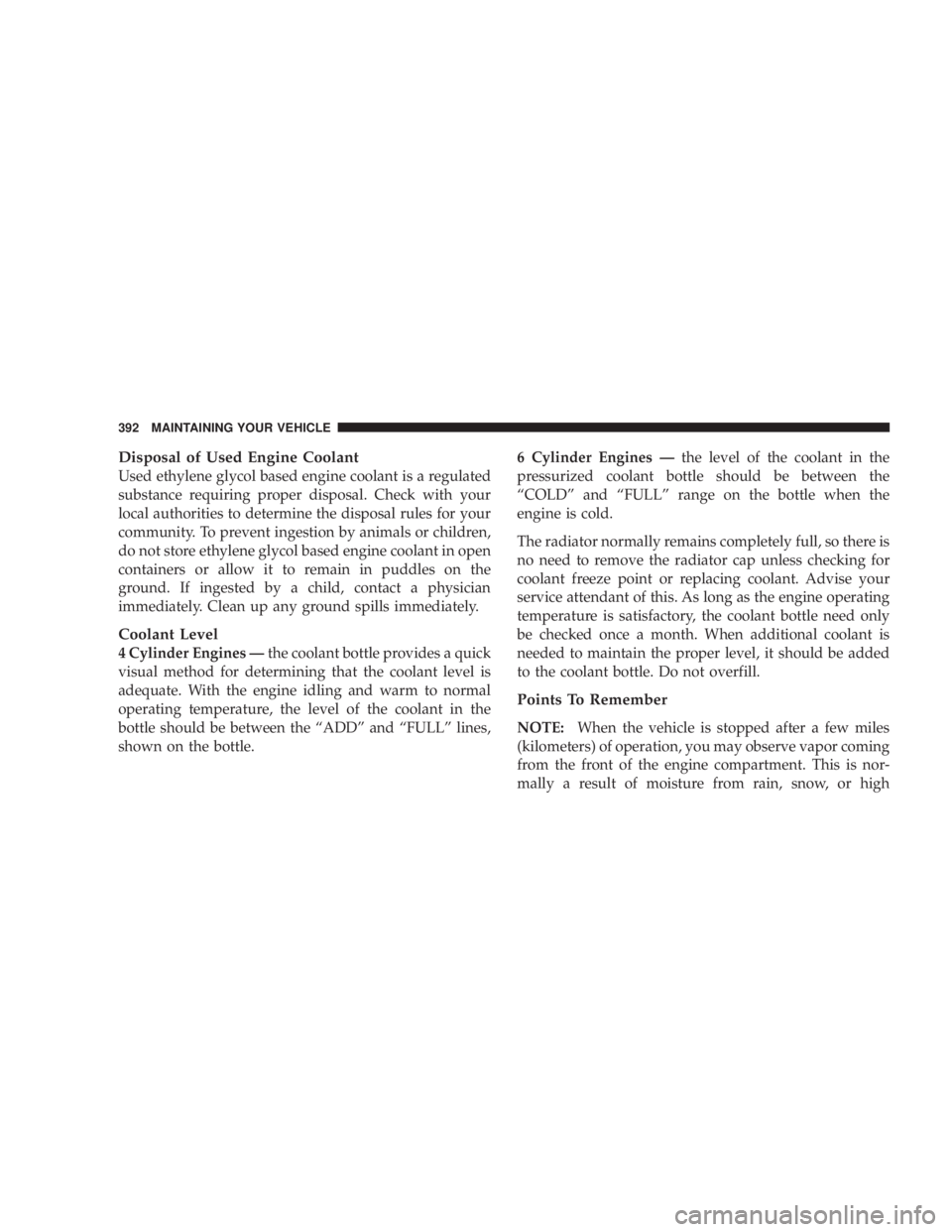
Disposal of Used Engine Coolant
Used ethylene glycol based engine coolant is a regulated
substance requiring proper disposal. Check with your
local authorities to determine the disposal rules for your
community. To prevent ingestion by animals or children,
do not store ethylene glycol based engine coolant in open
containers or allow it to remain in puddles on the
ground. If ingested by a child, contact a physician
immediately. Clean up any ground spills immediately.
Coolant Level
4 Cylinder Engines Ð the coolant bottle provides a quick
visual method for determining that the coolant level is
adequate. With the engine idling and warm to normal
operating temperature, the level of the coolant in the
bottle should be between the ªADDº and ªFULLº lines,
shown on the bottle. 6 Cylinder Engines Ð the level of the coolant in the
pressurized coolant bottle should be between the
ªCOLDº and ªFULLº range on the bottle when the
engine is cold.
The radiator normally remains completely full, so there is
no need to remove the radiator cap unless checking for
coolant freeze point or replacing coolant. Advise your
service attendant of this. As long as the engine operating
temperature is satisfactory, the coolant bottle need only
be checked once a month. When additional coolant is
needed to maintain the proper level, it should be added
to the coolant bottle. Do not overfill.
Points To Remember
NOTE: When the vehicle is stopped after a few miles
(kilometers) of operation, you may observe vapor coming
from the front of the engine compartment. This is nor-
mally a result of moisture from rain, snow, or high392 MAINTAINING YOUR VEHICLE
Page 395 of 467
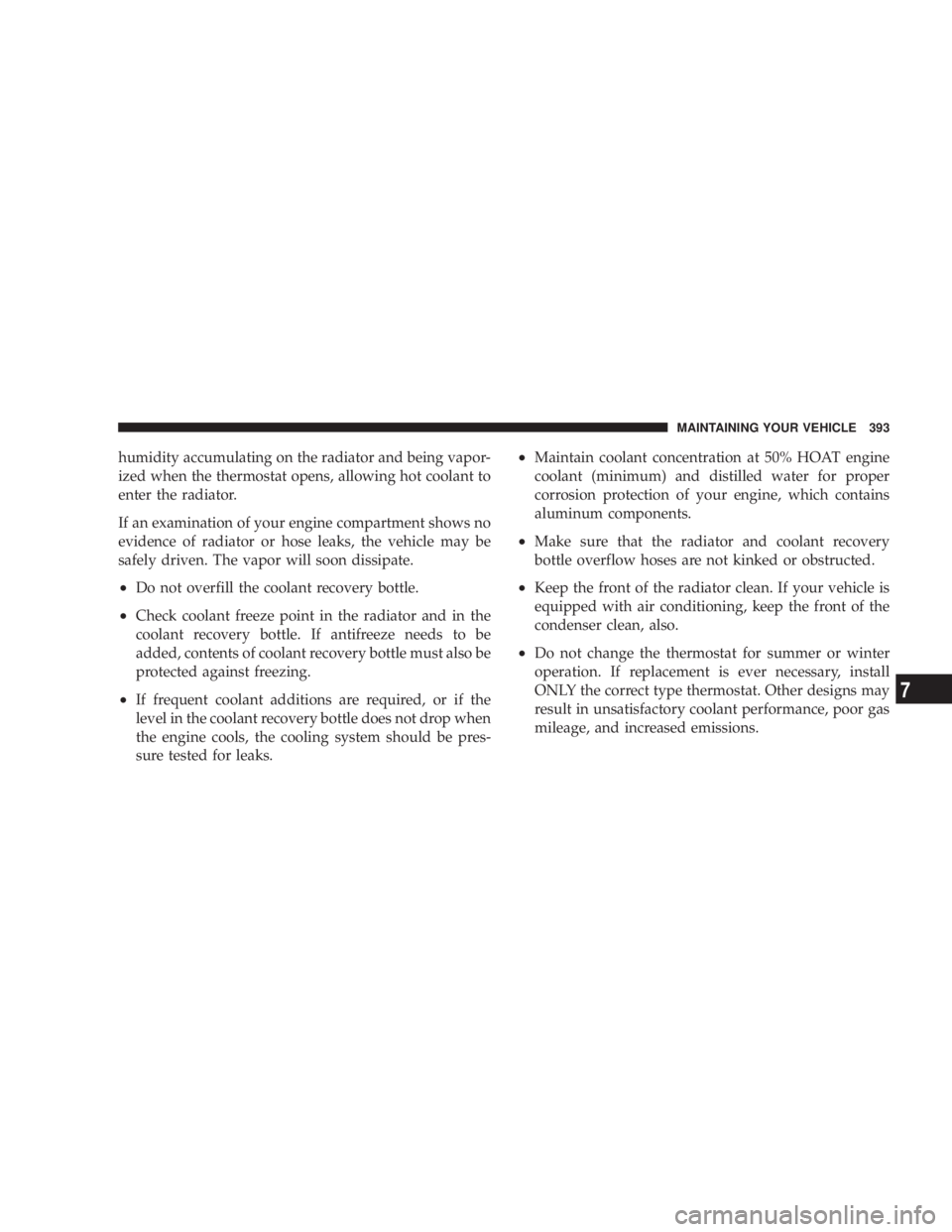
humidity accumulating on the radiator and being vapor-
ized when the thermostat opens, allowing hot coolant to
enter the radiator.
If an examination of your engine compartment shows no
evidence of radiator or hose leaks, the vehicle may be
safely driven. The vapor will soon dissipate.
² Do not overfill the coolant recovery bottle.
² Check coolant freeze point in the radiator and in the
coolant recovery bottle. If antifreeze needs to be
added, contents of coolant recovery bottle must also be
protected against freezing.
² If frequent coolant additions are required, or if the
level in the coolant recovery bottle does not drop when
the engine cools, the cooling system should be pres-
sure tested for leaks. ² Maintain coolant concentration at 50% HOAT engine
coolant (minimum) and distilled water for proper
corrosion protection of your engine, which contains
aluminum components.
² Make sure that the radiator and coolant recovery
bottle overflow hoses are not kinked or obstructed.
² Keep the front of the radiator clean. If your vehicle is
equipped with air conditioning, keep the front of the
condenser clean, also.
² Do not change the thermostat for summer or winter
operation. If replacement is ever necessary, install
ONLY the correct type thermostat. Other designs may
result in unsatisfactory coolant performance, poor gas
mileage, and increased emissions. MAINTAINING YOUR VEHICLE 393
7
Page 399 of 467
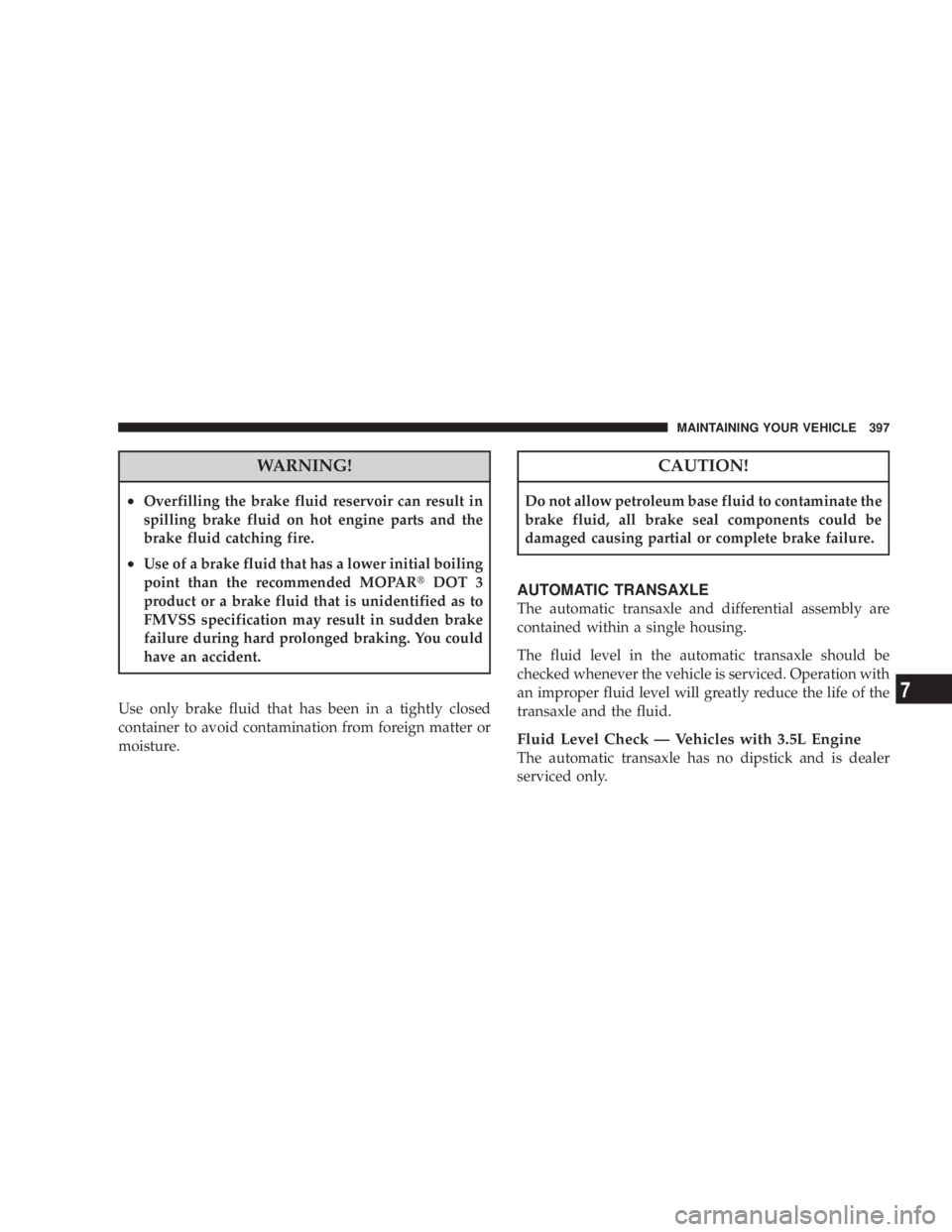
WARNING!² Overfilling the brake fluid reservoir can result in
spilling brake fluid on hot engine parts and the
brake fluid catching fire.
² Use of a brake fluid that has a lower initial boiling
point than the recommended MOPAR t DOT 3
product or a brake fluid that is unidentified as to
FMVSS specification may result in sudden brake
failure during hard prolonged braking. You could
have an accident.
Use only brake fluid that has been in a tightly closed
container to avoid contamination from foreign matter or
moisture. CAUTION!Do not allow petroleum base fluid to contaminate the
brake fluid, all brake seal components could be
damaged causing partial or complete brake failure.
AUTOMATIC TRANSAXLE
The automatic transaxle and differential assembly are
contained within a single housing.
The fluid level in the automatic transaxle should be
checked whenever the vehicle is serviced. Operation with
an improper fluid level will greatly reduce the life of the
transaxle and the fluid.
Fluid Level Check Ð Vehicles with 3.5L Engine
The automatic transaxle has no dipstick and is dealer
serviced only. MAINTAINING YOUR VEHICLE 397
7
Page 400 of 467
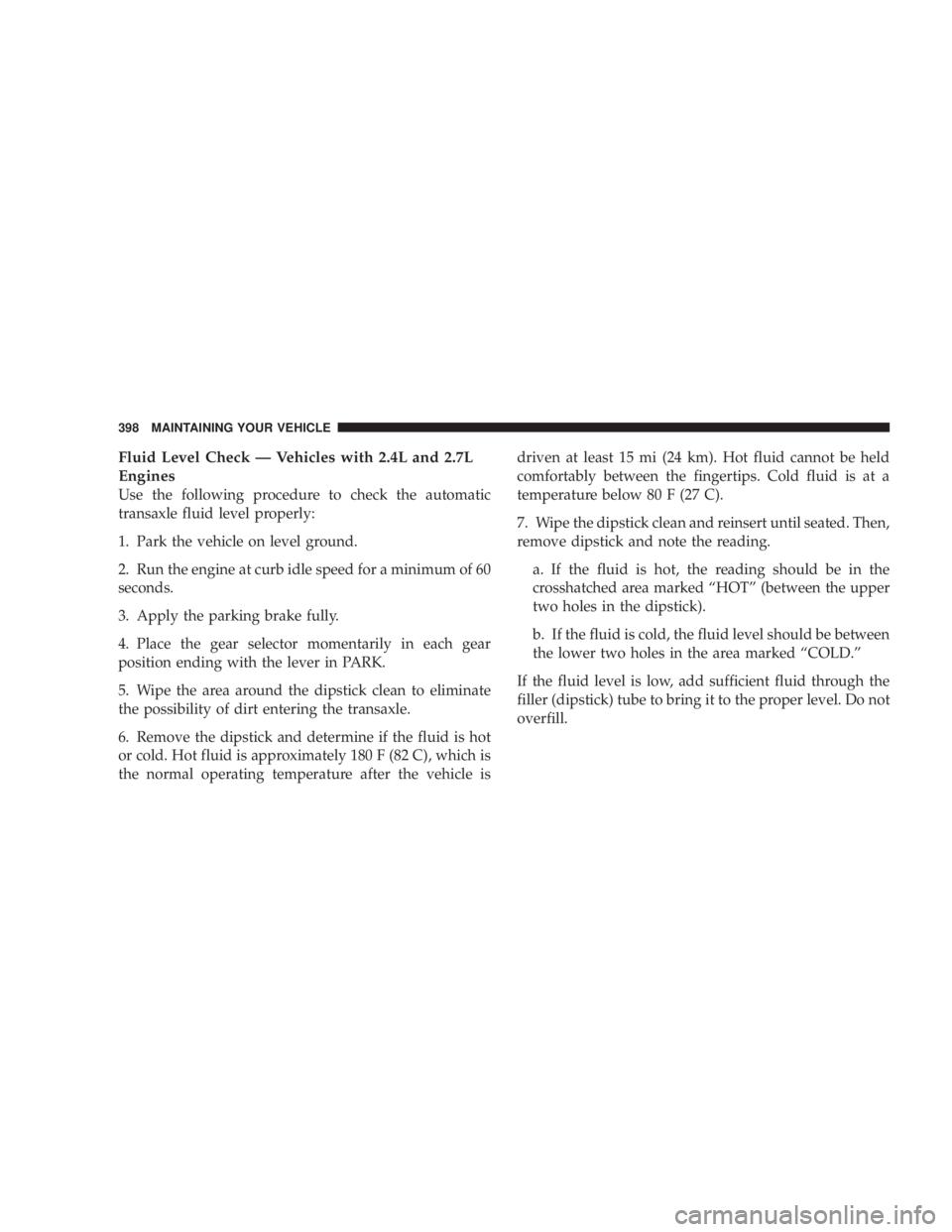
Fluid Level Check Ð Vehicles with 2.4L and 2.7L
Engines
Use the following procedure to check the automatic
transaxle fluid level properly:
1. Park the vehicle on level ground.
2. Run the engine at curb idle speed for a minimum of 60
seconds.
3. Apply the parking brake fully.
4. Place the gear selector momentarily in each gear
position ending with the lever in PARK.
5. Wipe the area around the dipstick clean to eliminate
the possibility of dirt entering the transaxle.
6. Remove the dipstick and determine if the fluid is hot
or cold. Hot fluid is approximately 180 F (82 C), which is
the normal operating temperature after the vehicle is driven at least 15 mi (24 km). Hot fluid cannot be held
comfortably between the fingertips. Cold fluid is at a
temperature below 80 F (27 C).
7. Wipe the dipstick clean and reinsert until seated. Then,
remove dipstick and note the reading.
a. If the fluid is hot, the reading should be in the
crosshatched area marked ªHOTº (between the upper
two holes in the dipstick).
b. If the fluid is cold, the fluid level should be between
the lower two holes in the area marked ªCOLD.º
If the fluid level is low, add sufficient fluid through the
filler (dipstick) tube to bring it to the proper level. Do not
overfill.398 MAINTAINING YOUR VEHICLE
Page 401 of 467
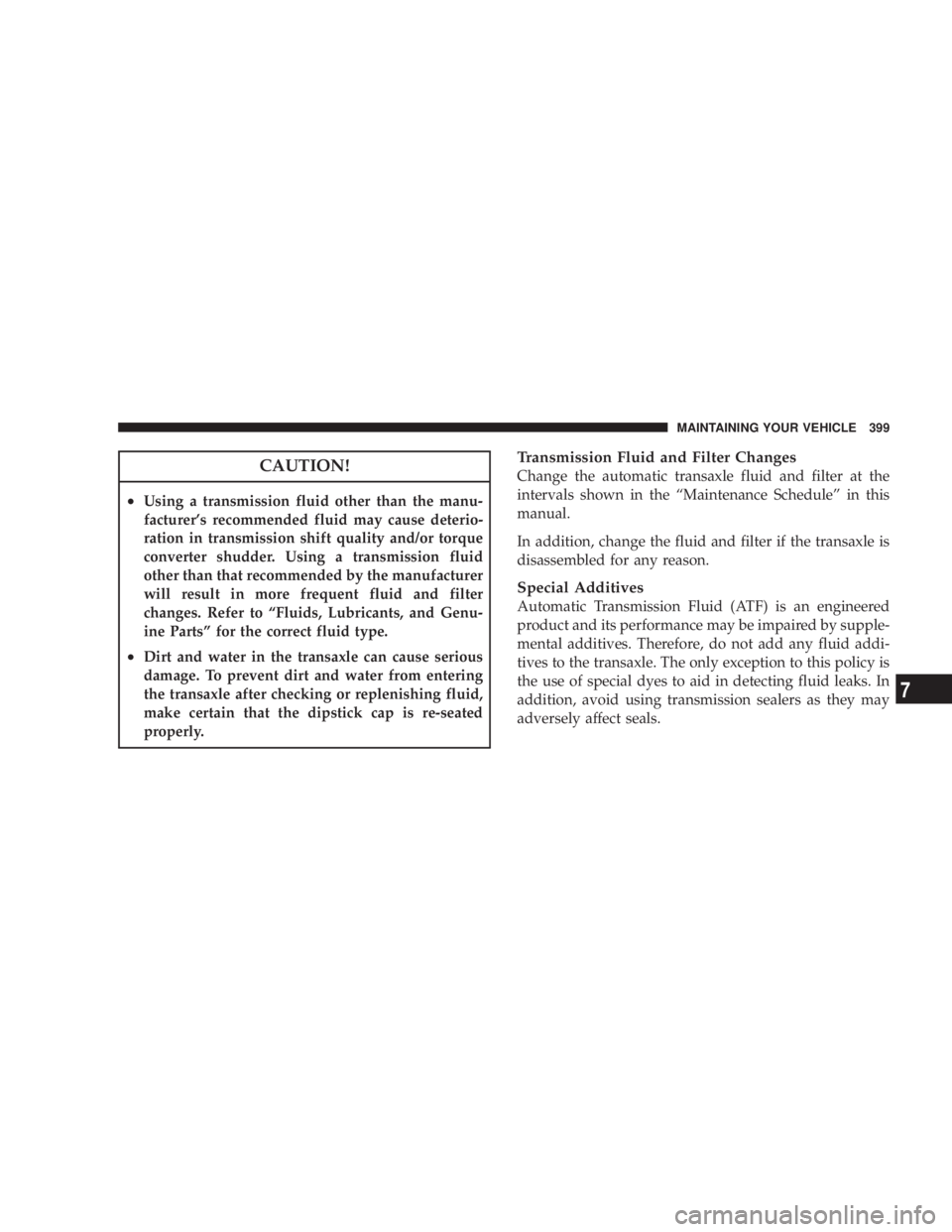
CAUTION!² Using a transmission fluid other than the manu-
facturer's recommended fluid may cause deterio-
ration in transmission shift quality and/or torque
converter shudder. Using a transmission fluid
other than that recommended by the manufacturer
will result in more frequent fluid and filter
changes. Refer to ªFluids, Lubricants, and Genu-
ine Partsº for the correct fluid type.
² Dirt and water in the transaxle can cause serious
damage. To prevent dirt and water from entering
the transaxle after checking or replenishing fluid,
make certain that the dipstick cap is re-seated
properly. Transmission Fluid and Filter Changes
Change the automatic transaxle fluid and filter at the
intervals shown in the ªMaintenance Scheduleº in this
manual.
In addition, change the fluid and filter if the transaxle is
disassembled for any reason.
Special Additives
Automatic Transmission Fluid (ATF) is an engineered
product and its performance may be impaired by supple-
mental additives. Therefore, do not add any fluid addi-
tives to the transaxle. The only exception to this policy is
the use of special dyes to aid in detecting fluid leaks. In
addition, avoid using transmission sealers as they may
adversely affect seals. MAINTAINING YOUR VEHICLE 399
7
Page 429 of 467
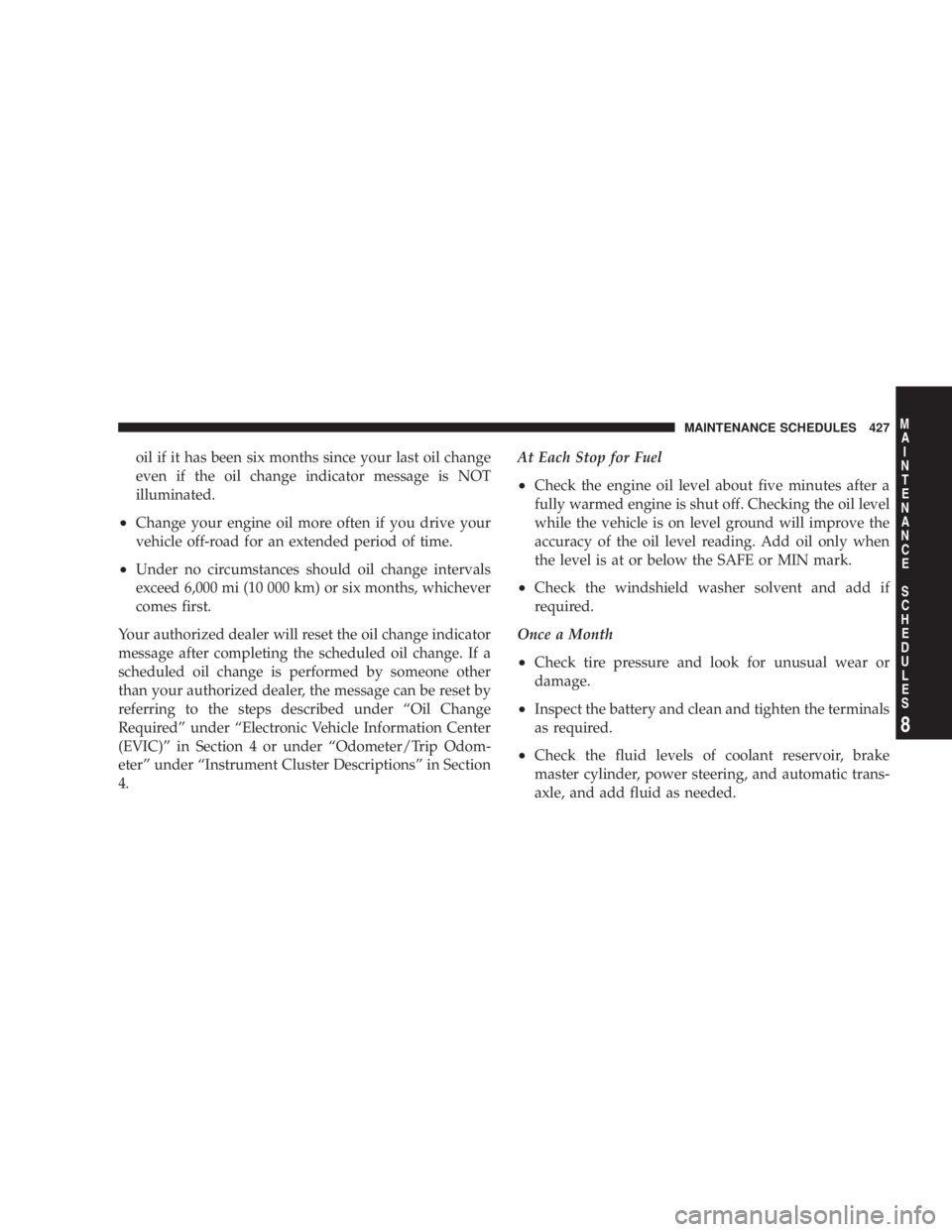
oil if it has been six months since your last oil change
even if the oil change indicator message is NOT
illuminated.
² Change your engine oil more often if you drive your
vehicle off-road for an extended period of time.
² Under no circumstances should oil change intervals
exceed 6,000 mi (10 000 km) or six months, whichever
comes first.
Your authorized dealer will reset the oil change indicator
message after completing the scheduled oil change. If a
scheduled oil change is performed by someone other
than your authorized dealer, the message can be reset by
referring to the steps described under ªOil Change
Requiredº under ªElectronic Vehicle Information Center
(EVIC)º in Section 4 or under ªOdometer/Trip Odom-
eterº under ªInstrument Cluster Descriptionsº in Section
4. At Each Stop for Fuel
² Check the engine oil level about five minutes after a
fully warmed engine is shut off. Checking the oil level
while the vehicle is on level ground will improve the
accuracy of the oil level reading. Add oil only when
the level is at or below the SAFE or MIN mark.
² Check the windshield washer solvent and add if
required.
Once a Month
² Check tire pressure and look for unusual wear or
damage.
² Inspect the battery and clean and tighten the terminals
as required.
² Check the fluid levels of coolant reservoir, brake
master cylinder, power steering, and automatic trans-
axle, and add fluid as needed. MAINTENANCE SCHEDULES 427
8 M
A
I
N
T
E
N
A
N
C
E
S
C
H
E
D
U
L
E
S
Page 430 of 467
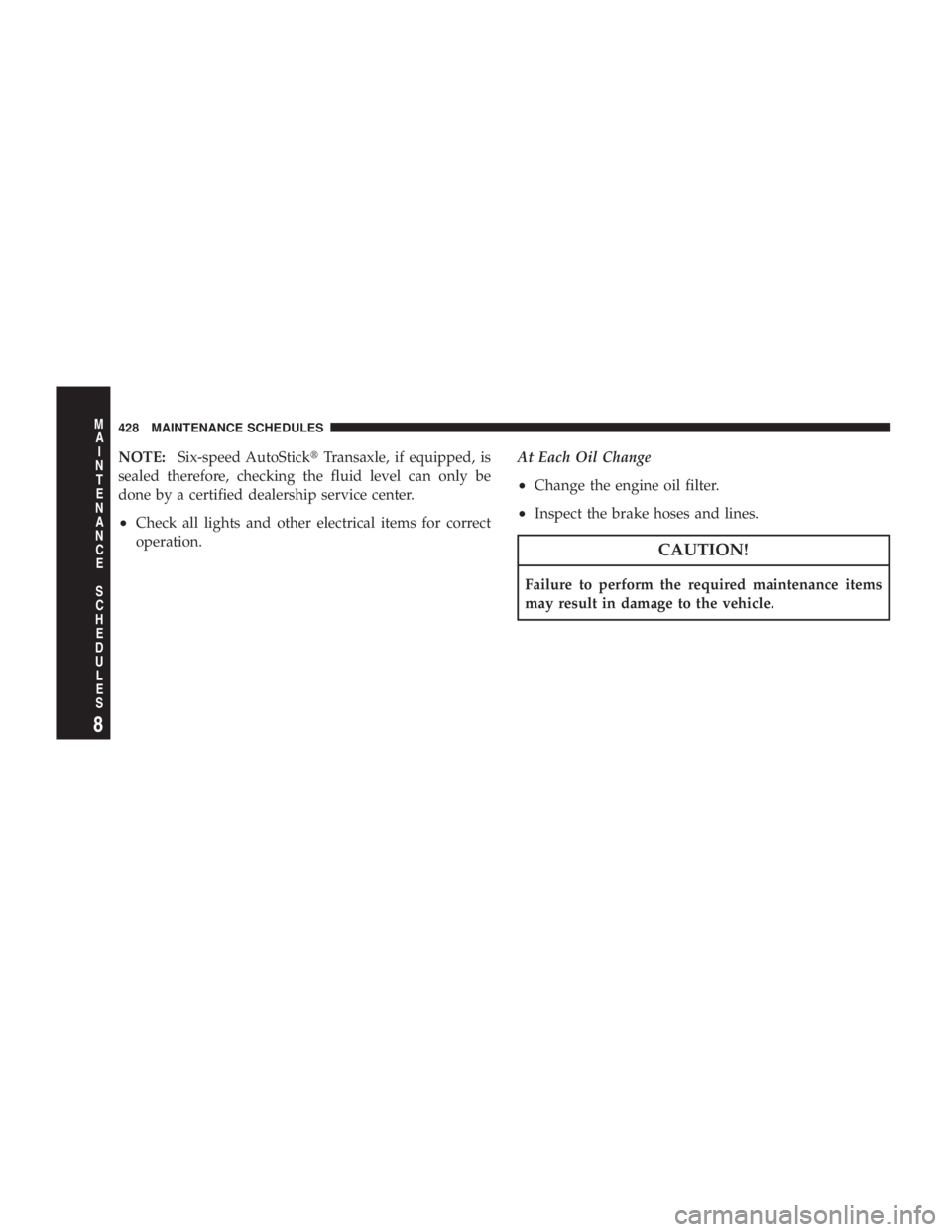
NOTE: Six-speed AutoStick t Transaxle, if equipped, is
sealed therefore, checking the fluid level can only be
done by a certified dealership service center.
² Check all lights and other electrical items for correct
operation. At Each Oil Change
² Change the engine oil filter.
² Inspect the brake hoses and lines.
CAUTION!Failure to perform the required maintenance items
may result in damage to the vehicle.428 MAINTENANCE SCHEDULES
8 M
A
I
N
T
E
N
A
N
C
E
S
C
H
E
D
U
L
E
S
Page 448 of 467
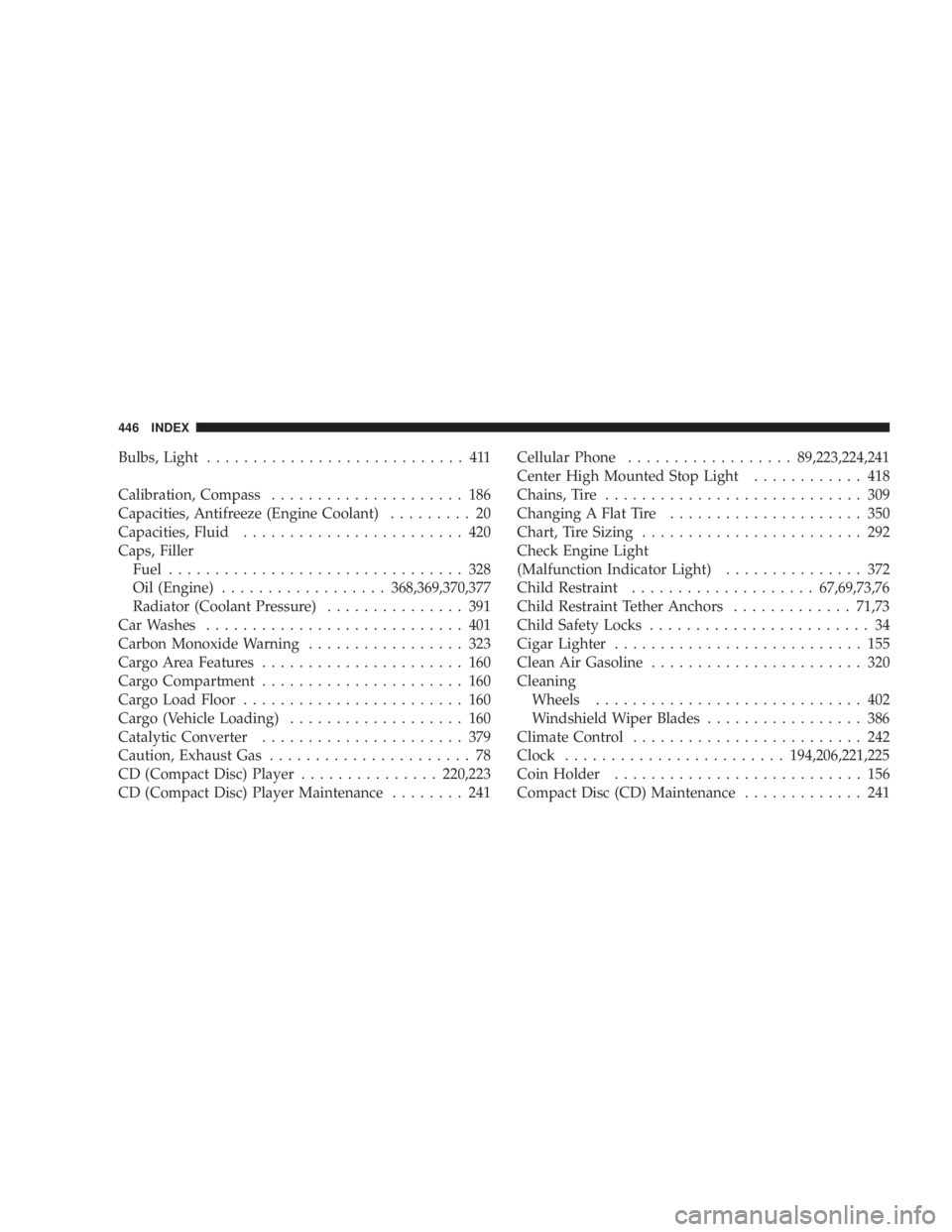
Bulbs, Light ............................ 411
Calibration, Compass ..................... 186
Capacities, Antifreeze (Engine Coolant) ......... 20
Capacities, Fluid ........................ 420
Caps, Filler
Fuel ................................ 328
Oil (Engine) .................. 368,369,370,377
Radiator (Coolant Pressure) ............... 391
Car Washes ............................ 401
Carbon Monoxide Warning ................. 323
Cargo Area Features ...................... 160
Cargo Compartment ...................... 160
Cargo Load Floor ........................ 160
Cargo (Vehicle Loading) ................... 160
Catalytic Converter ...................... 379
Caution, Exhaust Gas ...................... 78
CD (Compact Disc) Player ............... 220,223
CD (Compact Disc) Player Maintenance ........ 241 Cellular Phone .................. 89,223,224,241
Center High Mounted Stop Light ............ 418
Chains, Tire ............................ 309
Changing A Flat Tire ..................... 350
Chart, Tire Sizing ........................ 292
Check Engine Light
(Malfunction Indicator Light) ............... 372
Child Restraint .................... 67,69,73,76
Child Restraint Tether Anchors ............. 71,73
Child Safety Locks ........................ 34
Cigar Lighter ........................... 155
Clean Air Gasoline ....................... 320
Cleaning
Wheels ............................. 402
Windshield Wiper Blades ................. 386
Climate Control ......................... 242
Clock ........................ 194,206,221,225
Coin Holder ........................... 156
Compact Disc (CD) Maintenance ............. 241446 INDEX
Page 450 of 467
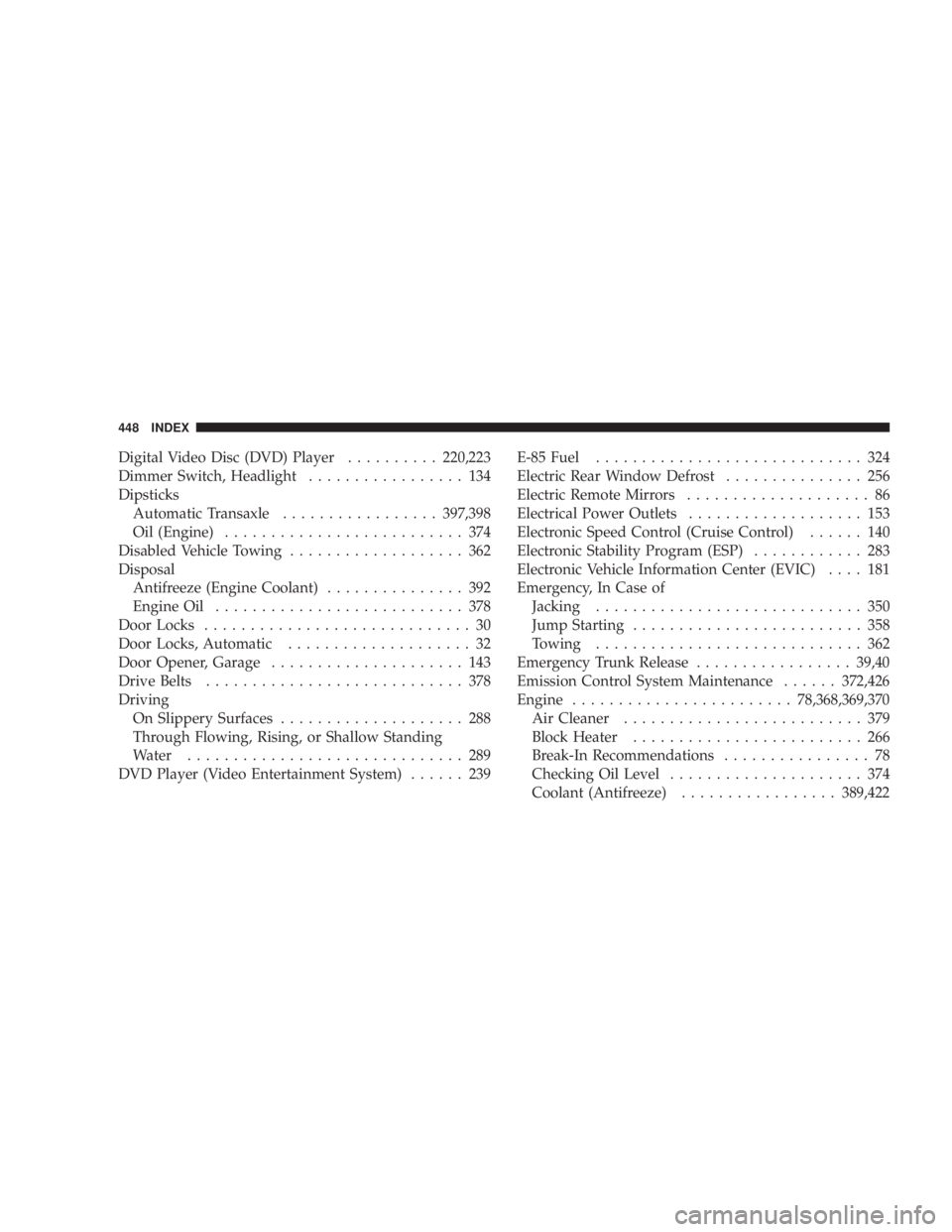
Digital Video Disc (DVD) Player .......... 220,223
Dimmer Switch, Headlight ................. 134
Dipsticks
Automatic Transaxle ................. 397,398
Oil (Engine) .......................... 374
Disabled Vehicle Towing ................... 362
Disposal
Antifreeze (Engine Coolant) ............... 392
Engine Oil ........................... 378
Door Locks ............................. 30
Door Locks, Automatic .................... 32
Door Opener, Garage ..................... 143
Drive Belts ............................ 378
Driving
On Slippery Surfaces .................... 288
Through Flowing, Rising, or Shallow Standing
Water .............................. 289
DVD Player (Video Entertainment System) ...... 239 E-85 Fuel ............................. 324
Electric Rear Window Defrost ............... 256
Electric Remote Mirrors .................... 86
Electrical Power Outlets ................... 153
Electronic Speed Control (Cruise Control) ...... 140
Electronic Stability Program (ESP) ............ 283
Electronic Vehicle Information Center (EVIC) .... 181
Emergency, In Case of
Jacking ............................. 350
Jump Starting ......................... 358
Towing ............................. 362
Emergency Trunk Release ................. 39,40
Emission Control System Maintenance ...... 372,426
Engine ........................ 78,368,369,370
Air Cleaner .......................... 379
Block Heater ......................... 266
Break-In Recommendations ................ 78
Checking Oil Level ..................... 374
Coolant (Antifreeze) ................. 389,422448 INDEX